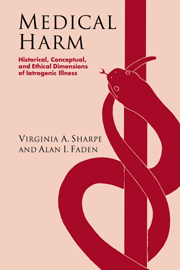Book contents
Introduction
Published online by Cambridge University Press: 22 September 2009
Summary
'Tis impossible to separate the chance of good from the risk of ill.
David HumeThe phrase ‘medical harm’ seems paradoxical. It defies our expectations about medicine; our expectations that medicine will benefit, rather than harm us and that individual and institutional providers will improve rather than diminish our health. But iatrogenic illness – literally, illness that is ‘induced by the physician’ – has come to be recognized as a significant source of patient risk. In the United States, it has been estimated that during hospitalization, as many as a third of patients suffer from complications related to their medical or nursing care. Between 5% and 13% of hospital admissions result from the adverse effects of diagnosis or treatment. The 1991 Harvard Medical Practice Study concluded that almost 70% of iatrogenic complications are preventable and affect more than 1.3 million hospitalized patients annually. During the fee for service era, patients were believed to be at considerable risk for unnecessary treatments. Today, there is growing concern regarding the risks associated with economically-motivated denials of necessary care.
In the last half of the twentieth century, attention to the problem of medically induced illness in the United States has come from a number of sources including the medical and legal professions, federal agencies and consumer advocacy groups.
It was in the 1950s and 1960s, after the enormous post-war expansion in pharmacological therapies, that the occurrence of iatrogenic complications – particularly adverse drug reactions – began to receive attention in the medical literature.
- Type
- Chapter
- Information
- Medical HarmHistorical, Conceptual and Ethical Dimensions of Iatrogenic Illness, pp. 1 - 18Publisher: Cambridge University PressPrint publication year: 1998



